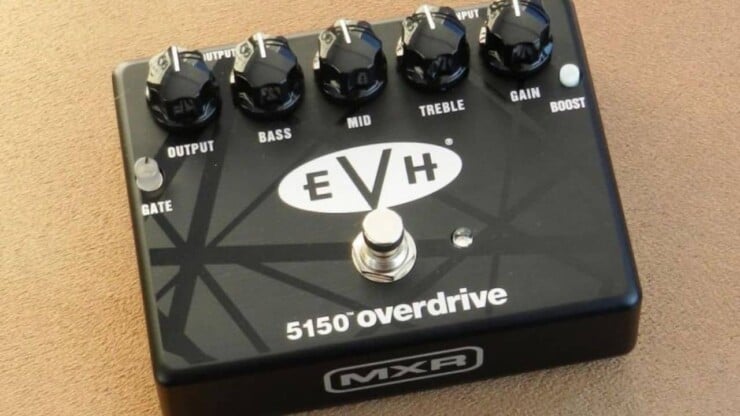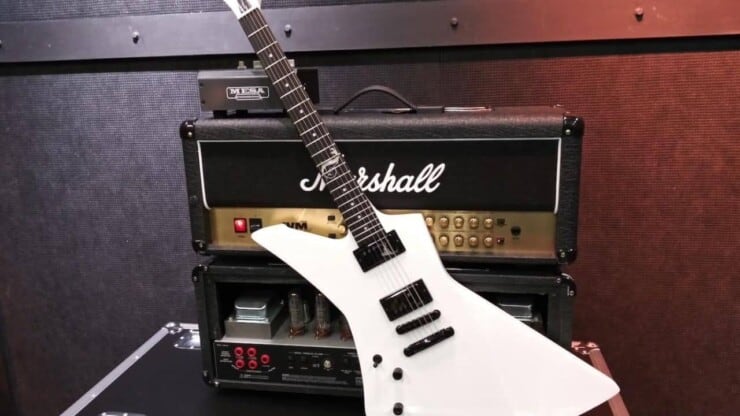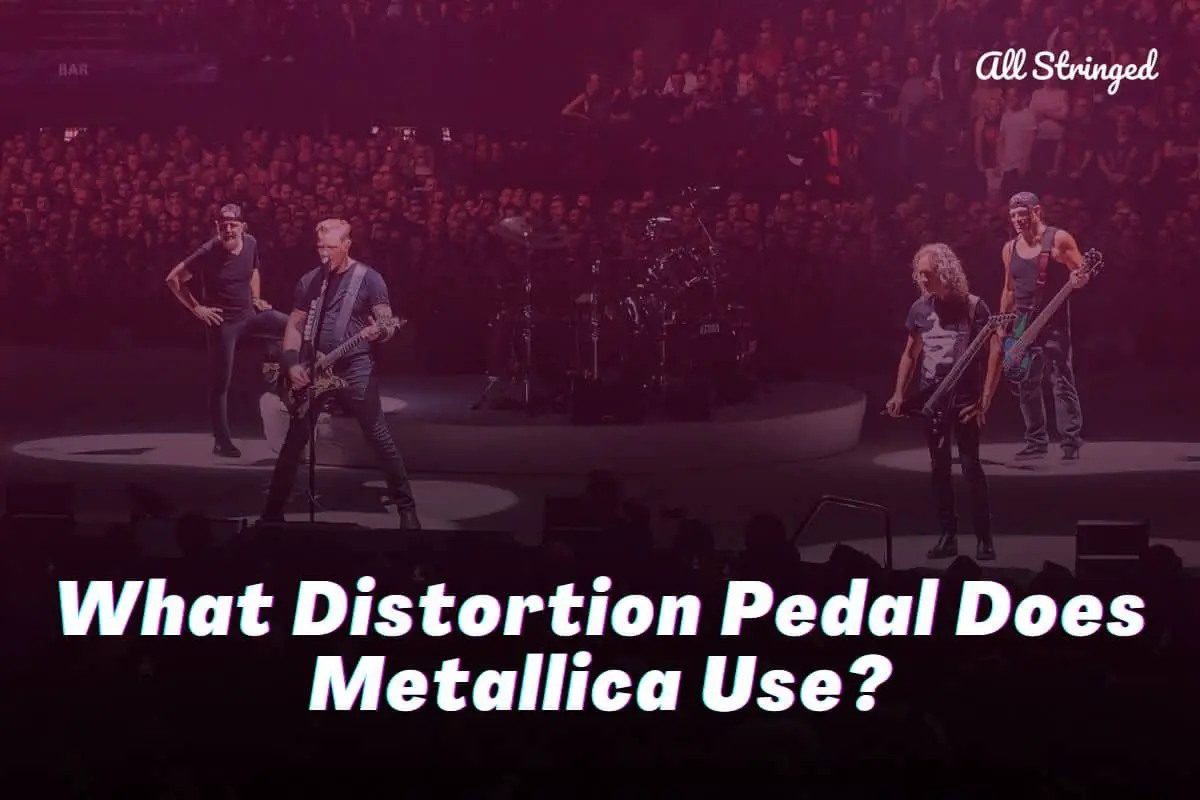Are you inspired by Metallica and want to play like them and get the signature distortion effect in your music? If so, then you’ll be glad to know it is possible.
The distortion pedal that Metallica used was the MXR 5150 EVH Signature Overdrive, ProCo RAT, and Ibanez Tube Screamer. In Metallica’s heyday, distortion pedals weren’t as advanced as they are today. However, despite the limitations, Metallica’s sound was always top-notch.
In this article, you’ll get to know all about Metallica’s music, what distortion pedal does Metallica use, the setup and guitar rig of the iconic band, what distortion pedal does James Hetfield use, and more. Stick around to get all the answers.
Metallica – An influential band that inspired generations of guitarists
Whether you’re an experienced guitarist or a beginner, you would have heard about Metallica. Metallica is one of the most influential and iconic bands that have inspired guitarists throughout the decades. As Metallica has made such a significant impact in the industry, it’s evident that guitarists are interested in their rig.
In 2022, there is no shortage of electric guitars, amps, pedals, and distortion effects of suitable ordinance. This will help you put together a rig that can help you emulate a sound similar to Metallica’s James Hetfield. For all the gear that the legendary Hetfield has used in his iconic career, from the early days with hot-rodded Marshalls, the Mesa/Boogie MkII era, and others, the key ingredient in his sound was the jackhammer right hand.
His guitar setup was truly a force of nature, especially the jackhammer right hand. A right hand designed innately and with sci-fi performance, it’s super creative and punishing. It’ll take some practice and lots of patience to bring the downstrokes up to speed such that you’re able to hit eighth notes at 200BPM. There has been no finer rhythm guitarist in the industry that can challenge Hetfield for the greatest guitarist spot. It’s almost impossible to possibly emulate his skillset.
Matching him note-for-note will take a lot of practice and dexterity in the picking hand. You’ll also need to dig out your metronome, start slowly, build some strength, and maintain accuracy. While you cannot match the legendary James Hetfield for skills, you can at least look to emulate a similar sound. One of the biggest helping hands is to know the exact setup and use it to get a similar sound.
What distortion pedals does Metallica use?
Metallica isn’t very distinguished when it comes to using pedals for achieving their core tones. James Hetfield stated that he preferred the direct distorted tone from an amp instead of relying on pedals. With that said, during Metallica’s heyday, distortion pedals and other effects weren’t as advanced as today. Moreover, there were only a handful of effect pedal options available.
JHS Modded ProCo RAT “Pack Rat”
When considering what distortion pedal does James Hetfield use, he was a big fan of the JHS Modded ProCo RAT. He used this distortion pedal during his early days before he ended up shifting to the Ibanez Tube Screamer. The latter offered more ancillary gain. Despite having a high-gain amp, the ProCo RAT is a no-brainer for adding to your arsenal. The modded version from JHS Pedals offered three clipping options for shaping the gain that suited the Metallica era. Moreover, the distortion components have been improved, which makes for improved clarity and quieter operation.
What amplifiers did Metallica use?
James Hetfield’s gone has gone through many changes over the years. At the start, it was all mid-range Marshall bark. The glassy crunch of “Kill ‘Em All” is largely believed to have come from Trouble’s live settings. This can be apocryphal, a footnote of metal mythology. But either way, it’ll remain a high-water point for any guitar player looking for a quality metal guitar tone.
By the time Metallica and James Hetfield were in Denmark, tracking “Master of Puppets” with Fleming Rasmusen, Hetfield had started using the Mesa/Boogie Mark IIC+ heads and Mesa Cabinets. With the mid-range dialed back what really gave Hetfield’s tone the 3D quality and power was the multitracking.
The band would layer dozens of tracks on top of one another, stopping only once things started getting muddy. If you’re recording and feel that the tone is a little thing, you can double it. Then, you should double it once more. However, you should remember that you have to keep it 100% accurate, or it’ll turn to mush.
Mesa/Boogie Mark V
Unfortunately, the Mesa/Boogie Mark IIC+ that is often associated with Metallica’s foundational rhythm tone has been out of production. The Californian titans of boutique guitar amps have now moved on to Mark V in the series. With as many as 3 channels and switchable voicing for each, it’ll be an amp that can do more than just Metallica. While it is expensive, it’ll be the only amp that you’d need and want to use.
As with many Mesa amps, it’ll be a tweaker’s delight. It features a 3-band EQ for each channel while having a five-band graphic EQ that offers a comprehensive level of control over the tone. The tight, high-gain of channels will be just what you require to emulate a James Hetfield tone. With some careful EQ, you’ll be in a great place to nail the tone of the peak era of Metallica. The switchable power output will make it well suited for a wide variety of contexts. The lowest 10W setting will be loud enough to peel off paint from the wall.
Mesa/Boogie Rectified Standard Slant Speaker Cabinet
If you’re looking to get some serious air and make the most of the Boogie Mark V head, you can get a matching Mesa/Boogie cabinet. It’ll be big and unwieldy, but there will be nothing like playing loud music through a half-stack. As with the Boogie Mark V, the build will be impeccable, and you’ll have a void-free Baltic birch cabinet that houses a quartet of Celestion Vintage 30 speakers.
Mesa/Boogie Mark V:35 Combo
In case the head and cabinet option is a bit much, the Mesa/Boogie Mark V:35 will be a great option. It’ll offer the convenience of being an all-in-one 1×12 combo format. It’s a phenomenal amp with channel-assignable low-power settings, allowing you to switch the power from 35W to 25W or 10W.
There are two channels, each one of them featuring three different voicings. It can be partnered with a dirt box, and channel two’s Mark IIC+ will be useful for chasing the vintage Metallica tone. The Extreme Mode has been taken from the Mark V head and will be ideal for thick, high-gain crunch.
There are numerous great features. Moreover, like the Mark V, you’ll get a 3-band EQ for each channel while having a 5-band graphic EQ. There is even a wonderful tube-driven spring reverb for adding a little spice to your tone. It’ll be ideal if you’re playing live and require more depth.
Roland JC-120 Jazz Chorus
This amp has been Hetfield’s chosen option for getting the clean tones since Metallica toured with The Cult in 1989. He was mesmerized and heavily impressed as soon as he saw Billy Duffy use it. The JC-120 is essentially a two 60W amplifier in one and features a lush onboard chorus. As a standalone amp, it’s loud enough and has heaps of detail and headroom.
Line 6 Spider V 120 MkII Modeling Combo
What you need at that price is a choice of extremely usable clean tones and a few high-gain tones that can be dialed in a Hetfield-esque level of crunch. The exceptional Line 6 Spider V 120 MkII is ideal for such circumstances. It’ll represent remarkable value, with 128 presets and over 200 models of amps, effects, and cabinets.
It also features an onboard looper with a maximum recording time of a minute. This makes it a great device for training your picking hand. You can record a riff to the onboard metronome, play the loop back, and practice the riffs over the top.
What effect pedals to use to get the Metallica sound?
MXR 5150 EVH Signature Overdrive
With many brands producing flexible stompboxes capable of imitating the tones of distorted valve amps, this is a great option. The MXR 5150 EVH Signature Overdrive is a high-gain pedal that has the needed features that you’d find on a genuine amp channel. It’s based on the EVH 5150 amplifier, an iconic head that is used by many metal bands over the years. Widely praised for its dynamic high-gain tone, the MXR 5150 Overdrive will encompass the distinctive sound. Moreover, it’ll also feature a powerful 3-band EQ section that will ensure that it sounds great for almost any amp.

With a built-in boost circuit, you can tighten up the overall sound of the pedal. It’ll be similar to when you place a Tubescreamer-esque stompbox ahead of a distorted amp. The MXR 5150 Overdrive’s noise gate will be another thoughtful addition, as it eliminates the frustrating hiss that occurs when running an ultra-hot amp.
MXR Analog Chorus & Tone & Tone City Angel Wing
As mentioned before, the Roland JC-120 Jazz Chorus was a key source for Metallica’s clean tones. It was used both in the studio and during live performances. For emulating its elite, washy chorus effect, you can go for a couple of other chorus pedal options. These will help you imitate the JC-120’s wonderful sound.
One of the best ones is the popular MXR Analog Chorus pedal that uses an old-school bucket-brigade circuit. This is very similar to the original Boss CE-1 units. It offers you a bold yet warm chorus sound while featuring all the key controls that one would expect. Moreover, there are two EQ controls that will allow you to boost or cut the lows and highs.
Another option would be the Tone City Angel Wings, which is a great-sounding pedal. Although it doesn’t have similar flexibility as the MXR counterpart, it’ll deliver as unmistakable analog tone.
Jim Dunlop CBM95 Cry Baby Mini Wah
Kirk Hammett of Metallica is essentially a borderline wah addict. Once, quipping that he’d need to have someone physically hold his legs to stop him from using this wah pedal. He employed this effect in most of his pentatonic-based guitar solos. With a Jimi Hendrix influence evident, Hammett made use of wah in a heavier context to not just achieve a screaming lead tone, but also for allowing his playing to cut through in frantic mixes.
Kirk Hammett used his own Jim Dunlop KH95 Signature Wah pedal, although it was more expensive than most standard wahs. As an alternative, you can go for the CBM95 Cry Baby Mini, which is a compact version of Dunlop’s flagship GCB95 wah model. It’ll give you a wide sweep despite a tiny footprint. This pedal also features an internal voicing switch that can adjust its spectrum, allowing you to attain crazy highs like Hammett’s very own custom wah.
What guitars did Metallica use to get the iconic Metallica sound?
James Hetfield and Kirk Hammett were both long-term ESP endorsers. No group has done more to bring a brand to the public than Hetfield and Hamett’s continual use of the signature Electronic Sound Product (ESP) axes. As a result, they’ve had dozens of variations through the years. Both these players have an affinity for active pickups. However, beyond this, they’ll have relatively different tastes.

James Hetfield is fond of guitars that are styled after Gibson’s Moderne shapes of the late 50s. Some early Metallica records have seen both him and Kirt using Gibson Flying Vs. However, he is best known for using Explorer-shaped guitars. Hetfield’s 80s ESP models feature a close resemblance to Gibsons. Somewhere down the line, the ESPs were obliged legally to alter the design. These days, there are many “X” shaped guitars out there, with ESP offering plenty of their own. For the uninitiated, LTD is the more affordable sibling of ESP. ESPs are Japanese while LTDs are licensed models, which are made in regions like Indonesia.
ESP LTD EX-200
This is the current take on the iconic Explorer-style, and it’ll turn out to be an enormous value for money. The LTD EX-200 will feature a mahogany body as well as a set neck with a bound fingerboard. This will lend the instrument a solid, authoritative feel. High output pickups and extra-jumbo frets will allow you to get the riff on straight away.
ESP LTD KH-202
The LTD KH-202 is a gorgeous bolt-on-necked superstrat that comes with the skull ‘n’ crossbone inlays. It features a great neck profile while having a Floyd Rose tremolo for all the Puppets-era screeching solos. The reverse headstock will be an authentic finishing touch, as this great value ax will need to make it insta-Kirt.
ESP LTD Snakebyte
As for the LTD Snakebyte, these guitars will all have professional quality and will be built to be toured repeatedly. For the Hetfield choice, you’ll have the Snakebyte signature model, with a tastefully chunked-out Explorer shape. Every hard-rocking guitar company will offer their exclusive Explorer style, and this shape is arguably the best re-drawing of the classic. It’ll come in Black, White, Snow, and Camo.
The Snakebyte will be, as you’d expect, a slab of mahogany. This mode will feature Hetfield’s signature EMG “Het Set” Pickup. The active models have been designed to deliver a mids-rich tone with huge output but low background noise levels. The pickups will be perfect for staccato riffing, as you’d find on the “Master of Puppets” riff. It has long been an honor among metal hordes that anyone who is attempting this evil, chromatic riffs will do it with downstrokes only. It isn’t easy at all. To be fair, alternate picking techniques will sound different. The result will be well worth the effort to learn it.
Conclusion
Thank you for reading. Hopefully, now you know a lot more about Metallica’s music, what distortion pedal does Metallica use, the setup and guitar rig of the iconic band, what distortion pedal does James Hetfield use, and more. Metallica is easily one of the most iconic and legendary bands in the world. James Hetfield ranks as one of the finest guitarists of all time, someone who has long been an inspiring guitarist.
The distortion pedals that James Hetfield and Metallica used included ProCo RAT, Ibanez Tube Screamer, MXR 5150 EVH Signature Overdrive, and more. During Metallica’s heyday, the distortion pedals and other effects weren’t as advanced as they are in today’s market. Despite the limitations, Metallica has always had a top-notch sound and become a legendary band.
Image Credit:
Images: Sweetwater, Spinditty



